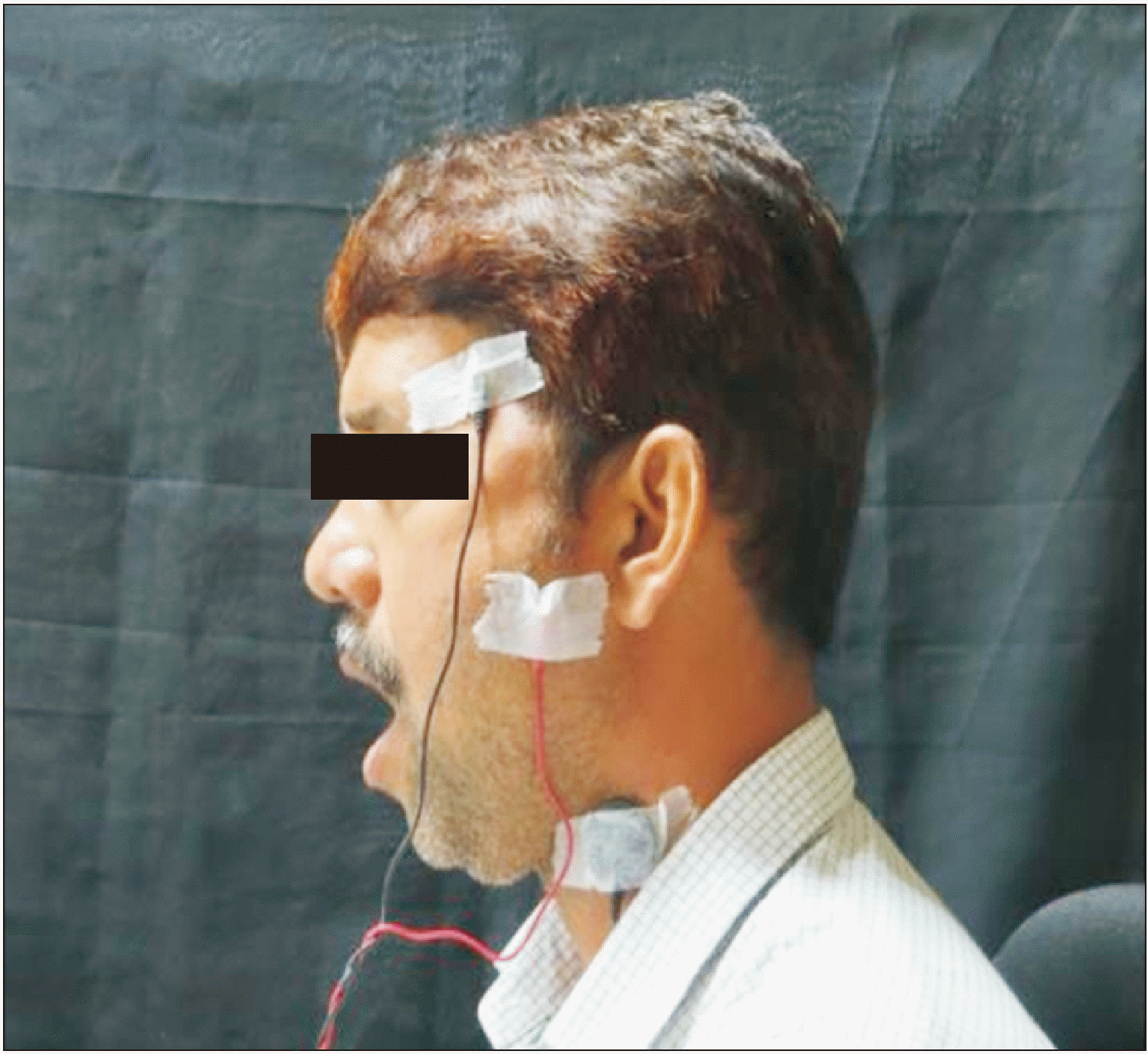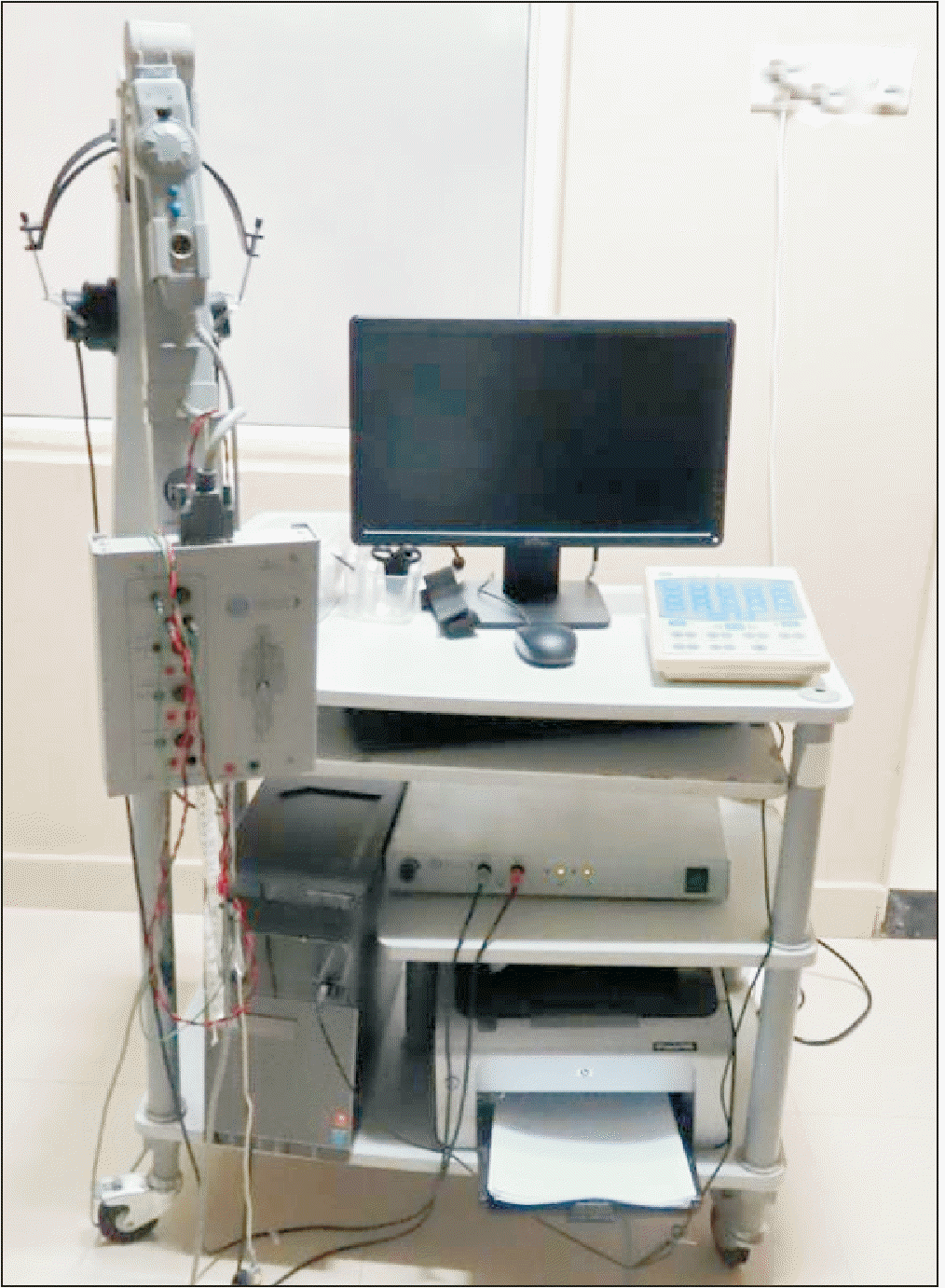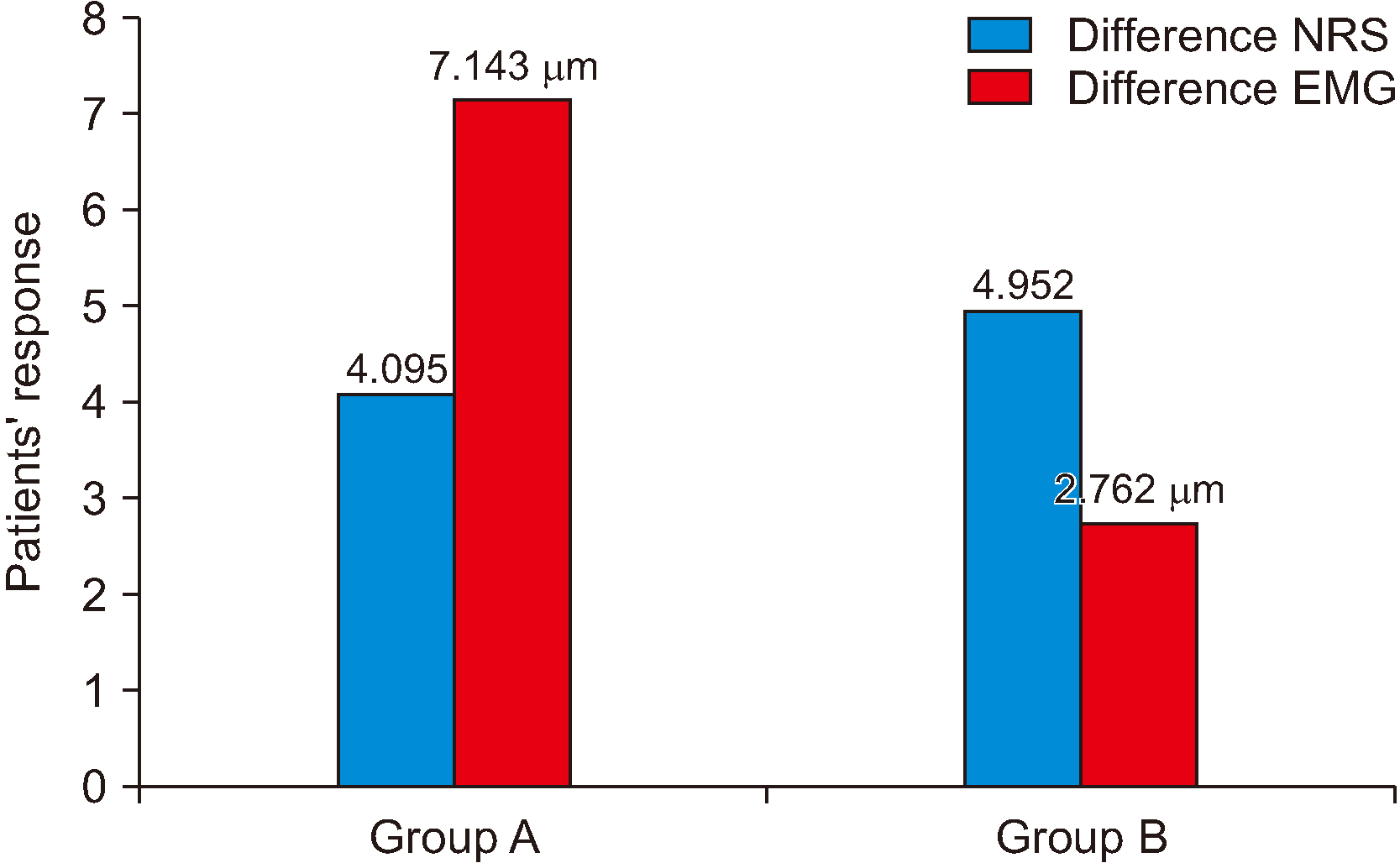I. Introduction
The masticatory system is a sophisticated system composed of temporomandibular joint (TMJ), muscles, ligaments, and teeth. The TMJ is also known as the bi-arthrodial joint, compound joint, or ginglymoarthroidal joint because it allows for hinge movement and translatory movement
1
. Temporomandibular disorder (TMD) is a musculoskeletal ailment that affects almost 25% of the population. Common causes include behavioral stress, parafunctional habits, and direct or indirect trauma to the associated musculature. However, 70% of the cases are due to malposition of the temporomandibular disc. Pain compromises the functional activity of masticatory muscle, resulting in uncoordinated and hyperactive activity
2
. Thus, any variation in the masticatory muscle activity pattern during static and dynamic function is an efficient means to detect disturbance in mandibular activity. Orofacial pain in the preauricular region, tenderness on palpation, reduced mouth opening due to muscle spasm, a clicking or popping sound, and deviation and deflection in the path of mandibular movements are common signs and symptoms of this ailment
3
.
Surface electromyography (SEMG) has been used as a diagnostic tool for TMD. It is used to detect various pathological and dysfunctional conditions like hyperactivity, hypoactivity, and muscle fatigue, along with valuation of the effectiveness and success of personalized treatments
4
.
Various treatment modalities are available for TMD, and physical therapies are the first line of treatment to improve and restore function of the masticatory apparatus. Almost 90% of patients responded positively to conservative therapies, which include behavioral modification or self-management, jaw exercises, and physical therapies
5
. Thermo-therapy is the oldest modality and is still well accepted and commonly used as a self-manageable home remedy. Application of moist heat on affected muscles is highly effective since diffusion of moist heat helps in vasodilation, thereby improving the blood flow to the affected muscles and removal of metabolic waste products to provide relief from joint dysfunction and muscle pain
6
.
Ultrasound (US) is used as both a diagnostic and a therapeutic measure in the field of medicine. Similarly, a low pulse ultrasound of about 1 MHz has been widely used to treat tendinitis and bursitis since the early 1950s. Production of acoustic energy in the ultrasonic range causes heat production and vibration of tissues through a process called cavitation
7
. The main objectives of electrotherapy modalities, such as ultrasound, are pain relief and muscle hyperactivity or spasm relief
8
. This approach is believed to be superior to superficial thermotherapy because it allows the heat to penetrate into deeper tissues, improving the extensibility of collagen tissues and relieving joint stiffness
9
.
Although a subjective analysis of the effectiveness of moist heat and ultrasound therapy has been documented, there is less evidence for objective analysis of the same approach. Therefore, this research was performed to evaluate and compare the efficacy of moist heat and ultrasound therapies on relieving the symptoms associated with TMD, using a numeric rating scale (NRS) as a subjective analysis tool and SEMG as an objective analysis tool to assess and understand the pre-interventional and post-interventional masseter and temporalis muscle tonicities in patients with masticatory muscle myalgia.
Go to :

II. Materials and Methods
The study included 42 masticatory myalgia patients that reported to the Department of Prosthodontics, Nitte (Deemed to be University) from November 2017 to September 2019. The study was approved by the Ethical Committee of AB Shetty Memorial Institute of Dental Sciences (No. ABSM/EC31/2017). Informed consent from patients between 20-50 years of age was obtained, and the patients were then screened using Research Diagnostic Criteria for Temporomandibular Disorder (DC/TMD) for Axis-1
10
.
Inclusion criteria:
Exclusion criteria:
-Subjects suffering from any neurologic disorders.
-Subjects with a past history of rehabilitation therapy for TMD.
-Subjects on analgesics.
-Subjects with traumatic injuries.
-Subjects with a previous history of rheumatic disorders, fractures, or surgeries.
-Subjects suffering from persistent pain for three or more months.
-Subjects with any pathologic findings on TMJ radiographs.
The procedure was performed with the help of a primary and a secondary investigator to prevent subject bias. Initial diagnostic evaluation was conducted by the primary investigator using the digital palpation method for evaluating the affected muscle
1
. The temporalis muscle was palpated at the anterior, middle, and posterior regions. The masseter muscle was palpated by instructing the patient to clench their teeth. The severity of pain was rated on the NRS
11
(
Fig. 1) from 0 to 10, where a score of 0 was perceived as no pain and a score of 10 was perceived as the highest pain level. Tonicity of affected muscles was documented using electromyography (EMG).(
Fig. 2) After thorough examination, patients were randomly divided into two groups of 21 subjects each for treatment.
 | Fig. 1Numeric rating scale used for pain assessment. 
|
 | Fig. 2Electromyography recording of temporalis muscle in function. 
|
Group A: Patients received moist heat therapy for 20 minutes as a home remedy
2,12
. This therapy was repeated twice a day with a time interval of eight hours for seven consecutive days. The therapy was performed by placing a hot, wet towel over the affected region for 20 minutes.
Group B: Patients received ultrasound therapy at the Department of Physiotherapy
13
. The therapy was performed over the affected muscles using an ultrasound probe with a diameter of 5 cm
2. Patients that underwent this treatment were exposed to a continuous mode of ultrasound energy at 0.8 W of power and 1 MHz of frequency (used for deeper tissues) for 10 minutes in the area of interest. This session was repeated for seven working days.
The post treatment pain response was analyzed by the secondary investigator who was blinded to type of treatment. Pain severity was recorded using a NRS. Similarly, EMG readings were gathered to analyze the effectiveness of each modality post-intervention. The EMG records muscle activity by trapping and measuring the electricity generated by the muscles. These readings are collected using electrodes and transmitted to the electromyograph for presentation as an electromyogram.(
Fig. 3)
 | Fig. 3RMS Salus 4C electromyograph machine (RMS, India). 
|
Go to :

IV. Discussion
Currently, there are no reliable procedures or devices that can be used by researchers or practitioners to diagnose or evaluate the presence and severity of TMD
6
. In the majority of patients with TMD, the muscles are either hyperactive or hypoactive; this abnormal activity can be utilized as an efficient method to detect any functionally disturbed mandibular conditions. In this analysis, EMG was used to test this asymmetry in muscle activity
17
. Since 1950, EMG has being used in dentistry to evaluate muscle activity due to its ability to assess the electrical characteristics and behavior of impacted muscles.
In a systematic review by Suvinen and Kemppainen
18
, EMG was suggested as an adjunct research tool to study masticatory functions. In 1991, Cooper et al.
19
discovered that EMG of certain masticatory muscles in patients with clinically diagnosed craniomandibular dysfunction is a clinically helpful strategy for quantifying musculoskeletal dysfunction. Wang and peers noted an increase in SEMG activity in masticatory muscles due to pain that emanated from inner derangements. Santana-Mora et al.
20
found lower EMG values in chronic TMD patients, while Gervais et al.
21
found higher resting EMG values in TMD patients.
From the subjective analysis, it is evident that the participants in both treatment modality groups had a significant response on the NRS scale, and the majority of patients showed considerable relief from the pain after therapy. Although the pain level on the NRS shifted to mild from severe for all patients, the statistical analysis of the collected data given in
Table 3 shows that the mean differences in NRS scores for the treatment modalities were 4.095 and 4.952, respectively. These results statistically indicate ultrasound as a better method to alleviate pain, as the patients marked a higher difference on the NRS scale than that of the moist heat group. This observation is supported by a study performed by Esposito et al.
22
in 1984, which stated that ultrasonic therapy is extremely efficient in alleviating myofascial pain. In 1999, van der Windt et al.
23
evaluated the effectiveness of ultrasound therapy for treating musculoskeletal disorders, and the review supported use of ultrasonic therapy in musculoskeletal disorder treatment.
On objective analysis, the increase in mean value of EMG amplitude after therapy suggested a higher amplitude registration in the EMG, which indicates enhanced muscle activity. Hence, as in
Table 4, moist heat therapy showed a mean difference of 7.143 µm, which is significantly higher than the value for ultrasound therapy, which was 2.762 µm. This higher mean difference suggests that patients who underwent moist heat therapy had better muscle activity after the treatment, which suggests that moist heat therapy is superior to ultrasound for restoring the muscle activity of the affected muscle.
Based on these results, subjective assessment (NRS scale) indicates that ultrasound is superior to moist heat, while objective analysis (EMG scale) indicates that moist heat therapy is preferable to ultrasound. Since the study focused on the two parameters of pain and muscle activity, the NRS reading depends on patient senses; therefore, the mean difference comparison alone is not sufficient to determine the best treatment modality.
For a treatment to be qualified as the best treatment modality, it should be effective and equally consistent in all aspects. The standard deviation should be compared to assess the consistency for ultrasound and moist heat approaches.
Table 3 shows that the treatments are equally consistent because the standard deviation values are similar. The results for enhanced muscle activity showed that moist heat was very consistent, and that the standard deviation was just above one (1.005). However, after one week of observation, the ultrasound approach was found to lack consistency for improving muscle function as it was associated with a higher standard deviation of 4.158.
This finding is in agreement with a previous finding by Funk et al.
24
in 2001, showing that moist heat implementation for 20 minutes offered better hamstring flexibility than static stretching, which indicated enhancement for muscle fitness and connective tissue with moist heat therapy. This is due to enhanced vasodilation and an analgesic impact that increases the pain threshold, relieves muscle spasms by decreasing muscle spindle activity, and increases the extensibility of collagen fibres. For every 10°C increase in temperature, cellular and metabolic activity in the cells increases by two- to three-fold.
Similarly, Petrofsky et al.
25
concluded in his study that moist heat therapy had enhanced benefits compared to dry heat therapy in a shorter time. Further research from Petrofsky et al.
26
revealed that the result was attributable either to increased heat flux through the skin via moist air or to changes in the ionic environment around skin thermo receptors.
Gam and Johannsen
27
published a systematic review on 22 randomized clinical trials that assessed the effectiveness of ultrasound therapy for musculoskeletal conditions. They concluded that there was little evidence of the effectiveness of ultrasound therapy from well-designed trials, yet they hypothesized that ultrasound therapy might augment the effect of exercise therapy. Therefore, the effect of ultrasound therapy in improving muscle strength was augmented when it was performed along with home exercise regimens.
In addition, Fouda
28
in 2014 and Young and Dyson
29
in 1990, promoted the use of ultrasound therapy in combination with hyperthermia. It was thought that the combined effect of two or more treatment approaches would provide a synergistic effect that imparts a better therapy. Another study by El-Batouty et al.
30
in 1986 found that ultrasound had a significant impact on tissue regeneration, which was evident starting in the fifth week. Hence, these results suggest the need for further research to document the effectiveness of ultrasound therapy on relieving the signs of TMD by employing studies with longer treatment times, along with incorporation of mouth stretching exercises.
Temporomandibular disorders can be treated with moist heat therapy as a reliable and self-manageable treatment modality. EMG can be utilized as a diagnostic tool to analyze the effectiveness of treatments in relieving muscle hyperactivity.
Go to :





 PDF
PDF Citation
Citation Print
Print







 XML Download
XML Download